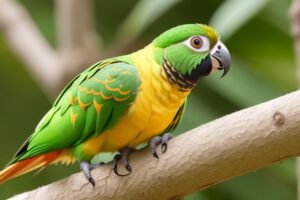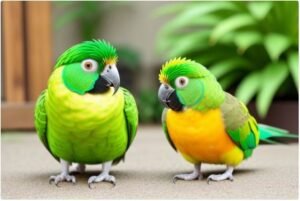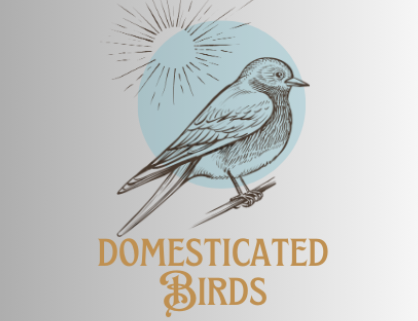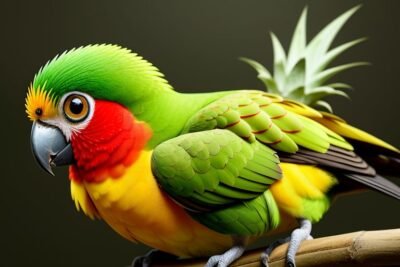Overview of the Species:
Picture a tiny bundle of joy adorned in a vibrant coat of feathers, ranging from lush greens to sunny yellows and warm oranges. That’s the Pineapple Green Cheek Conure for you! These delightful birds, native to the verdant forests of South America, are renowned for their striking appearance and playful demeanor. With their petite size and colorful plumage, they make for captivating companions that bring a burst of color and cheer into any home.
Importance of Understanding Their Care Needs:
Now, let’s talk about the nitty-gritty of caring for these feathered beauties. Like any pet, Pineapple Green Cheek Conures have their own set of needs that must be tended to with care and attention. From providing a varied and nutritious diet to ensuring plenty of mental and physical stimulation through toys and interaction, every aspect of their care contributes to their overall well-being. Understanding their dietary requirements, socialization needs, and potential health concerns is crucial for fostering a strong bond and ensuring a fulfilling relationship with your avian friend.

Pineapple Green Cheek Conure as a Pet
Affectionate Nature:
Having spent countless hours bonding with my own Pineapple Green Cheek Conure, I can confidently say that their affectionate nature knows no bounds. From gentle head scratches to cozy cuddle sessions, these birds thrive on human interaction and love nothing more than being close to their owners. Their unwavering loyalty and devotion make them more than just pets; they become cherished members of the family.
Intelligence:
Interacting with my Pineapple Green Cheek Conure has revealed just how intelligent these birds truly are. Through consistent training and positive reinforcement, I’ve witnessed my feathered friend master various tricks and commands, showcasing their remarkable cognitive abilities. Their eagerness to learn and problem-solve never fails to impress me, making each training session a rewarding experience for both of us.
Entertaining Antics:
One of the highlights of owning a Pineapple Green Cheek Conure is observing their playful and often hilarious antics. Whether they’re hanging upside down from their perch, performing acrobatic feats, or engaging in spirited games of peek-a-boo, these birds have an innate knack for keeping me entertained. Their boundless energy and zest for life never cease to bring a smile to my face, making every day with them a joyous adventure.

Adaptability to Different Living Situations:
As someone who has lived in both spacious homes and compact apartments, I can attest to the adaptability of Pineapple Green Cheek Conures to various living environments. Their compact size and adaptable nature make them well-suited for any living situation, whether it’s a bustling urban apartment or a quiet suburban home. Their ability to thrive in diverse settings ensures that they can find happiness and contentment wherever they are.
Ideal for Individuals and Families Alike:
Having experienced the companionship of Pineapple Green Cheek Conures both as a single individual and as part of a family, I can confidently say that these birds are well-suited for households of all kinds. Their sociable nature and gentle disposition make them wonderful companions for individuals seeking a loyal feathered friend. Additionally, their patience and tolerance make them suitable for families with children, provided proper supervision and care are provided.
Getting Started: Pineapple Green Cheek Conure for Beginners
Absolutely, the Pineapple Green Cheek Conure can be a suitable choice for beginners, provided they are willing to invest the time and effort required for their care. Here’s why:
Reasons it’s Suitable for Beginners:
Size and Temperament: Pineapple Green Cheek Conures are relatively small in size compared to some other parrot species, making them easier to handle and accommodate in terms of living space. Additionally, they are known for their friendly and playful personalities, which can make bonding with them a joyful experience for beginners.
Ease of Care: While all pets require some level of care, Pineapple Green Cheek Conures have relatively straightforward care needs compared to larger parrot species. Their dietary requirements are not overly complex, and they can adapt well to a variety of living environments, including apartments and smaller homes.

Affordability: Compared to some other exotic bird species, Pineapple Green Cheek Conures are often more affordable to purchase and maintain. Their initial cost may be lower, and ongoing expenses for food, toys, and veterinary care are generally manageable for beginners.
Trainability: These birds are highly intelligent and can be trained to perform simple tricks and behaviors, making them an engaging and interactive pet for beginners who are eager to bond with their new feathered friend.
Understanding Gender: Pineapple Green Cheek Conure Male vs. Female
Differences Between Male and Female
Physical Characteristics: One of the primary differences between male and female Pineapple Green Cheek Conures is their physical appearance. Males typically have brighter and more vibrant plumage, especially on their chest and head, while females may have slightly duller colors. Additionally, males often have larger and rounder heads compared to females.
Behavioral Traits: While there are no significant behavioral differences between male and female Pineapple Green Cheek Conures, some owners have reported subtle variations in personality. Males may be slightly more vocal and outgoing, while females might exhibit a quieter and more reserved demeanor. However, individual temperament can vary widely regardless of gender.
Reproductive Behavior: Female Pineapple Green Cheek Conures may display nesting behaviors, such as shredding paper or creating nests out of bedding material, especially during breeding season. Males may become more territorial and protective of their nesting area.

Which is Better as a Pet: Male or Female?
The decision between choosing a male or female Pineapple Green Cheek Conure ultimately depends on the preferences and lifestyle of the owner. Both genders can make wonderful pets, and neither is inherently better than the other. Here are some considerations to help guide your decision:
Personal Preference: Some owners may have a preference for the vibrant colors and potentially more outgoing personality of male conures, while others may appreciate the quieter and potentially more nurturing demeanor of female conures. Consider which traits align best with your personality and lifestyle.
Single Pet vs. Breeding: If you are looking for a pet companion and have no intention of breeding, the gender of the conure may not be a significant factor. Both males and females can form strong bonds with their owners and make affectionate companions.
Compatibility with Existing Pets: If you already have other birds or pets in your household, consider the dynamics between different genders and species. Introducing a conure of the opposite gender to your existing pet may lead to territorial or aggressive behavior, so careful consideration is necessary.
Comparing with Other Conures: What Sets the Pineapple Green Cheek Apart
Distinctive Appearance: The Pineapple Green Cheek Conure boasts a captivating blend of yellow, green, and orange feathers, setting it apart from the standard Green Cheek and Cinnamon mutations. This unique coloration adds visual appeal and makes the Pineapple Conure an eye-catching companion.
Enhanced Personality: While all Green Cheek Conure mutations share similar personality traits such as intelligence and playfulness, the vibrant appearance of the Pineapple variant may contribute to a more outgoing and confident demeanor. This can result in increased interaction and engagement with its owner, enhancing the bond between bird and human.

Conversation Starter: The striking colors of the Pineapple Green Cheek Conure often serve as a conversation starter, sparking interest and admiration from visitors. This can create opportunities for social interaction and education about avian companionship, enriching the overall experience of pet ownership.
Aesthetic Appeal: For individuals seeking a visually stunning pet bird, the Pineapple Green Cheek Conure offers a unique and aesthetically pleasing option. Its vibrant plumage adds vibrancy and beauty to any home environment, making it a delightful addition to the household.
Market Demand: Due to its distinctive appearance and popularity among bird enthusiasts, the Pineapple Green Cheek Conure may have higher demand and value compared to other Green Cheek Conure mutations. This can be advantageous for owners looking to invest in a pet with potential resale or breeding opportunities.
Pineapple Green Cheek Conure Size
Average Size and Weight
Pineapple Green Cheek Conures typically measure around 10 inches in length and weigh between 60 to 80 grams. Despite their small size, these birds are full of energy and enthusiasm.
Lifespan of Pineapple Green Cheek Conures
The lifespan of Pineapple Green Cheek Conures can vary depending on whether they are kept in captivity or living in the wild.
Lifespan in Captivity:
In a controlled environment with proper care and attention, Pineapple Green Cheek Conures can live an average of 10 to 15 years, though some individuals have been known to live up to 20 years or more.
Mortality causes in captivity:
The most common mortality causes of Pineapple Green Cheek Conures in captivity include improper diet, accidents, respiratory infections, and stress-related conditions.
Lifespan in the Wild:
In their natural habitat, Pineapple Green Cheek Conures face various challenges that can affect their lifespan. Predation, habitat loss, disease, and environmental factors all contribute to higher mortality rates in the wild. As a result, the average lifespan of Pineapple Green Cheek Conures in their natural habitat is generally shorter, ranging from 6 to 10 years.
Talking Talents of Pineapple Green Cheek Conures
Ability to Talk: Yes, Pineapple Green Cheek Conures can talk, demonstrating impressive mimicry skills.
Mimicking Human Speech: These intelligent birds can mimic human speech with proper training and repetition.
Training Techniques: To train a Pineapple Green Cheek Conure to talk, consistent repetition, positive reinforcement, and patience are essential.
Clear Communication: Using clear, distinct words and phrases in a gentle and encouraging manner facilitates the learning process.
Developing Vocabulary: With dedication and consistency, many Pineapple Green Cheek Conures can develop an impressive vocabulary, delighting their owners with their talking abilities.
Pricing: How Much Do Pineapple Green Cheek Conures Cost?
Pricing for Pineapple Green Cheek Conures can vary depending on factors such as breeder reputation, lineage, age, and coloration. On average, Pineapple Green Cheek Conures typically range from $200/$250 to $500 USD. However, prices can fluctuate based on demand and availability in different regions.
Ongoing expenses:
Cage and Accessories: The cost of a suitable cage, perches, toys, and other accessories to provide a comfortable and stimulating environment for the conure.
Food and Supplies: Monthly expenses for high-quality bird food, treats, and supplies such as bedding, cleaning products, and grooming tools.
Veterinary Care: Budgeting for regular check-ups, vaccinations, and potential medical expenses for preventive care and treatment of health issues.
Pros of Owning a Pineapple Green Cheek Conure:
Affectionate Bonding: Pineapple Green Cheek Conures form strong bonds with their owners, providing companionship and emotional support.
Intellectual Stimulation: These birds are intelligent and enjoy interactive activities, stimulating their minds and keeping them engaged.
Entertainment Value: With their playful antics and ability to mimic sounds, Pineapple Green Cheek Conures offer endless entertainment and amusement.
Adaptability: Their compact size and adaptable nature make Pineapple Green Cheek Conures suitable for various living environments, including apartments and homes.
Longevity: With proper care, Pineapple Green Cheek Conures can live for over a decade, offering years of companionship and joy.
Low Cost of Ownership: Compared to larger parrot species, Pineapple Green Cheek Conures require less space and have lower maintenance costs.
Aesthetic Appeal: Their vibrant plumage adds color and beauty to any home environment, enhancing the overall aesthetic.
Cons of Owning a Pineapple Green Cheek Conure:
Vocalization: Pineapple Green Cheek Conures can be noisy, especially during certain times of the day, which may disrupt household peace.
Destructive Behavior: Without adequate mental and physical stimulation, these birds may engage in destructive behaviors such as chewing on furniture or feathers.
Health Concerns: Pineapple Green Cheek Conures are prone to health issues such as respiratory infections and obesity, requiring regular veterinary care.
Time Commitment: Owning a Pineapple Green Cheek Conure requires time and dedication for feeding, cleaning, training, and socialization.
Mess: Birds can generate dust and droppings, necessitating frequent cleaning of their living space to maintain hygiene.
Social Needs: Pineapple Green Cheek Conures thrive on social interaction and may experience loneliness if left alone for extended periods.
Heartwarming Owner Success Stories: Tales of Pineapple Green Cheek Conure Companionship
Story 1: David’s Unbreakable Bond
David, an avid bird enthusiast, welcomed a Pineapple Green Cheek Conure named Joy into his home. From the moment they met, Joy’s playful personality and affectionate demeanor stole David’s heart. Through patient training and positive reinforcement, Joy learned to mimic David’s laughter and greet him with a cheerful “hello” every morning. Their bond grew stronger with each passing day, bringing immeasurable joy and companionship into David’s life.
Story 2: Rachel’s Unexpected Friendship
Rachel, a busy professional, initially hesitated to adopt a pet due to her demanding schedule. However, everything changed when she met Apple, a vibrant Pineapple Green Cheek Conure. Despite Rachel’s busy lifestyle, Apple quickly became her loyal companion, brightening even the toughest days with his playful antics and infectious energy. Together, they formed an unexpected friendship that brought warmth and laughter into Rachel’s home.
Story 3: Michael’s Healing Journey
Michael, coping with anxiety and depression, found solace in the company of his Pineapple Green Cheek Conure, Peanut. Peanut’s gentle presence and unwavering affection provided Michael with a sense of comfort and security during challenging times. Through their shared moments of laughter and quiet companionship, Peanut became Michael’s emotional support and a source of healing on his journey towards mental well-being.
Story 4: Sarah’s Joyful Adventure
Sarah, a nature enthusiast, embarked on a new adventure with her Pineapple Green Cheek Conure, Life. Together, they explored the great outdoors, from scenic hikes to leisurely picnics in the park. Life’s curiosity and zest for life inspired Sarah to embrace the simple joys of nature and live each day to the fullest. Their shared adventures created cherished memories that would last a lifetime.
Story 5: Jessica’s Lifelong Friendship
Jessica, a lifelong bird lover, found a kindred spirit in her Pineapple Green Cheek Conure, Peaches. From their first encounter, Peaches exuded warmth and affection, making Jessica feel instantly at ease. Together, they formed a deep bond built on trust, mutual respect, and unconditional love. Through life’s ups and downs, Peaches remained Jessica’s steadfast companion, a beacon of light in her darkest moments.
Conclusion:
In summary, the Pineapple Green Cheek Conure emerges as an exceptional choice for bird enthusiasts seeking a vibrant and affectionate companion. By understanding their care requirements and nurturing a strong bond, owners can experience the joy and companionship these birds offer. Their adaptability to different living situations and compatibility with other pets make them an ideal choice for both individuals and families. While their lifespan may vary, providing proper care ensures a fulfilling and enduring relationship. Despite initial expenses, the invaluable happiness and love these birds bring into their owners’ lives make them a worthwhile investment. Embarking on a journey with a Pineapple Green Cheek Conure promises countless moments of laughter, affection, and cherished memories.
Attention needed: Images used in this article are AI generated, as I was not able to take real images of these conures due to certain reason. I hope you guys understand.
FAQs:
Pineapple green cheek conure: Frequently Asked Questions:
Do Pineapple Green Cheek Conures Talk?
Yes, Pineapple Green Cheek Conures are known for their talking abilities. They can learn to mimic human speech and often develop a vocabulary of various words.
Are Pineapple Conures Friendly?
Absolutely! Pineapple Green Cheek Conures are renowned for their friendly and affectionate nature. They thrive on social interaction and enjoy bonding with their human companions through play and cuddles.
Are Pineapple Conures Loud?
Compared to some other parrot species, Pineapple Green Cheek Conures are relatively quiet. They may vocalize with chirps and squawks, especially during times of excitement, but they are not excessively loud birds.
Are Pineapple Conures Intelligent?
Yes, Pineapple Green Cheek Conures are highly intelligent birds. They are quick learners and can be trained to perform various tricks and behaviors with positive reinforcement techniques.
Can They Be Kept in Pairs?
Yes, Pineapple Green Cheek Conures can be kept in pairs or small groups. They are social birds and often thrive with the company of another conure. However, it's important to introduce them properly and monitor their interactions to ensure they get along well and do not exhibit aggressive behavior towards each other.


1 thought on “Pineapple Green Cheek Conure: All Your Queries Resolved!”